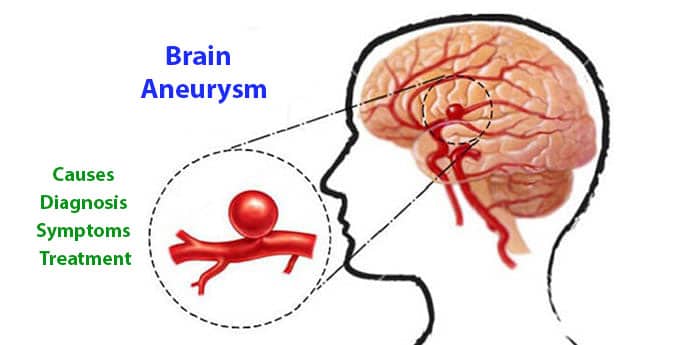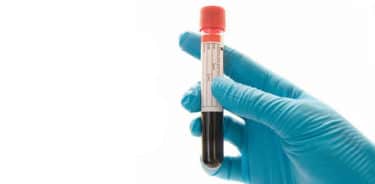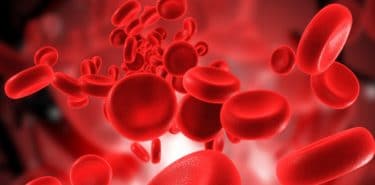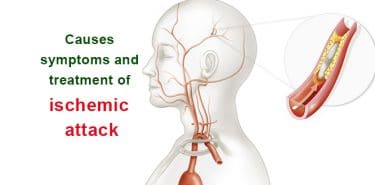Aneurysm is swelling or enlargement of an arterial wall due to weakening of vascular wall. Smoking, high blood pressure, high cholesterol, arteriosclerosis, and obesity are risk factors. But it could also be congenital. Aneurysms developing in the heart and brain region are very dangerous. If it tears, it can cause internal bleeding or death. Symptoms such as pain, nausea, vomiting, dizziness, low blood pressure and shock occur as a result of rupture of aneurysm, which requires immediate intervention. In order to diagnose problem early and take it under control, it is important to have regular health screenings especially for the people at risk. Aneurysm is usually treated with medication and surgical intervention.
Table of Contents
What is Aneurysm?
Aneurysm is swelling or enlargement of blood vessels when arterial wall weakens. It can emerge anywhere in the body. It usually has no symptoms and is not dangerous. But, aneurysm ruptures, which occur in the arteries feeding the brain and heart, lead to internal bleeding with life-threatening consequences. The likelihood of tearing depends on the size of the swelling and requires urgent intervention. (1)
What causes Aneurysm?
- Congenital heart defect (arterial septal defect)
- Family history of aneurysm
- Family history of heart disease or heart attack
- Aortic disease or injury
- Intense stress
- Hypertension
- High cholesterol
- Arteriosclerosis
- Poor diet and lifestyle
- Obesity
- Smoking
- Being over the age of sixty
Aneurysm occurs when an artery wall weakens. However, it is not exactly known what causes this defect. Nevertheless, it would be beneficial to reduce the factors that increase the risk. (2)
Symptoms of Aneurysm
- Pain
- Bleeding
- Cold and moist skin
- Dizziness
- Nausea and vomiting
- Racing heartbeat
- Shock
- Hypotension
- Painful and swollen mass close to the skin surface
Symptoms vary depending on where the aneurysm develops and its type. Aneurysm that occurs in the body or brain may not indicate any symptoms until it slowly expands and tears. But, it can prevent circulation in other tissues. (3)
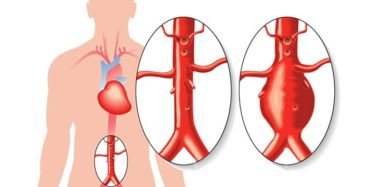
For example, it can lead to serious complications such as thromboembolism (obstruction or blockage of a blood vessel by a blood clot that dislodged from another blood vessel) or ischemic stroke (blockage of the artery feeding the brain due to the accumulation of blood clots).
Symptoms may also be associated with a condition that leads to the formation of it rather than aneurysm itself. For example, if it is caused by vasculitis (inflammation of the blood vessel), fever, fatigue, or weight loss may be experienced.
Headache due to aneurysm
As aneurysm in the brain expands or swells, it can put pressure on the nerves in the brain and cause quite severe and frequently recurring headaches, such as migraine. If such pain occurs, especially when you engage in any physical activity, such as sports, or lifting something heavy, getting on the toilet or after sexual intercourse, see a doctor immediately. (4)
Diagnosis of Aneurysm
Because aneurysm has usually shows no symptoms, it may not be detected in the body. For those who are at risk or who have symptoms, after having physical examination, one of the following imaging tests can be done depending on their condition: (5)
- Ultrasound: Part of preventive health screenings. Especially smoking men over 65-75 years old are recommended to undergo regular ultrasound screening against the risk of aortic aneurysm.
- Magnetic Resonance (MRI): Can display an aneurysm that has not yet been ruptured when symptoms are observed.
- Computed tomography (CT): Usually preferred in ruptured aneurysms, especially if there is a risk of brain bleeding.
- Angiography (Angio): Helps to identify the area of an aneurysm that develops or tears rapidly in the brain or heart, which requires urgent surgical intervention.
Types of Aneurysm
It is handled in two main groups according to type of development in vessel wall:
- Saccular an.: Develops on one side of the vessel wall.
- Fusiform an.: Develops on both sides of the vessel wall.
The most common types classified according to the region where they develop in the body are:
Aortic aneurysm
It is a type of that affects the main artery of the body. There are two types of abdominal aortic aneurysm (AAA) and thoracic aortic aneurysm (TAA).
AAA is the most common one. It develops in the main vein (aorta), which carries blood to the abdomen, pelvis and legs. Men over 60 years of age are more likely to develop or who have more than one of the above-mentioned risk factors. The most typical symptoms are pain in the abdomen, back or lumbar region. (6)
TAA, seen rarely, affects the part of the aorta that goes through the chest. The main cause is vascular stiffness. The common symptoms are hoarseness, troubled swallowing, increased frequency of breathing, pain in the chest and upper back, and swelling in the neck. (7)
You should seek urgent medical assistance in both aortic aneurysms.
Cerebral Aneurysm
As a matter of fact, an aneurysm that occurs in blood vessels deep in the brain can develop in any size. Particularly small-sized aneurysms do not usually cause symptoms and are less likely to develop complications. But, if they expand, they can put pressure on nerves and brain tissues.
Among leading symptoms are migraine-like headaches, pain in eyes, double vision, numbness on one side of the face, and tinnitus. Sudden and unbearable headache is the most typical symptom if aneurysm is ruptured. When symptoms are experienced, it requires immediate intervention without wasting any time. Because it causes fatal results within 24 hours. Most of the survivors may still have serious injuries.
Cerebral aneurysm can occur at any age, but it is most common in adults and women aged between 30 and 60 years old. People with congenital disorders are at high risk. In addition, among other important causes are conditions that damage the blood vessel wall in the brain including arteriosclerosis, head trauma, or infection.
Peripheral artery aneurysms
They are the aneurysms developing in arteries other than the main vessel, aorta, and have many types. The main ones include:
- Popliteal an.: Behind the knee (the most common peripheral aneurysm)
- Splenic an.: Near the spleen
- Mesenteric an.: In the guts
- Femoral an.: In the groin
- Carotid an.: On the neck
What is pseudoaneurysm? Why does it occur?
Pseudoaneurysm is a rupture of the vessel wall without swelling or enlargement in the artery. The blood is coagulated and covered with a membrane after the bleeding due to rupture, which does not affect all the layers forming the artery wall, such as aneurysm.
Its main reasons include infection, injury, side effects of intravenous drug use and stent placed in angiography.
Treatment of Aneurysm
Treatment can vary depending on the shape, size, type, risk of tearing of the aneurysm and the person’s age and general health. Among the main treatment methods include:
- Imaging tests: If it is identified after a health screening or observed symptoms, the patient may be offered regular imaging tests to keep the problem under control.
- Medications: Prevent the risk of developing aneurysms or the rupture of the existing aneurysm, especially in patients with high blood pressure or high cholesterol.
- Endavascular surgery: In some types, such as aortic aneurysm, stent can be surgically placed to strengthen the weakened vascular wall and prevent tearing.
- Open surgery: In life-threatening situations such as aortic or cerebral aneurysms, the patient urgently undergoes surgery. With this surgical intervention, bleeding is prevented by closing the artery.
Aneurysm surgery
Many different surgical techniques are employed depending on the type of aneurysms, which are rapidly expanding and at risk of tearing. But there are basically 2 different methods:
Closed (endavascular) surgical method
Surgeon inserts a tube into the artery of the patient’s leg or groin and advances it to the area of aneurysm. A small stent is then inserted into the damaged area and attached to the aorta. This intervention prevents tearing and strengthens the weakened wall.
The procedure may take one to 2 hours. Since recovery time (a few days) is short, it is preferred more often. It is commonly used in aortic aneurysm. It is less painful than the open surgical method, and has a lower risk of complications.
Possible risks include infection, stroke, stent slipping, or bleeding around the stent. The success rate of endavascular stents is 99%.
Open surgical method
Surgeon makes an incision in the concerned area under general anesthesia. For example, in aortic aneurysm, a large incision is made to the abdominal region in order to expose the aorta, and a stent replaces the damaged vein that is removed. In the brain aneurysm, a small hole is made into the skull and a clip like a ratchet is inserted into the vein to prevent blood flow to the aneurysm.
Open surgical method may have some disadvantages compared to the closed method. Surgery may take 3 to 5 hours or a little longer. In addition, the surgical site takes longer to heal (about one month). The risk of developing complications is also higher.
If cerebral aneurysm is not likely to tear, surgical intervention is not preferred due to serious surgical complications. In case of rupture, the damaged vessel is wrapped (platinum coil embolization), which prevents other possible bleedings.
Precautions before and after aneurysm surgery
Before aneurysm surgery
- Inform your doctor about all the medicines you are using (including supplements).
- Do not use any medication other than medication that your doctor wants you to take.
- Quit smoking and alcohol at least one week before surgery.
- Do not eat or drink anything 8 hours before surgery.
- Ask someone to help you in the hospital and at home.
After aneurysm surgery
- Do not neglect follow-up appointments.
- Use prescribed medications regularly and never take 2 doses at the same time if one dose is forgotten.
- Stop smoking and drinking altogether.
- Do not use any medicine or even supplement without consulting your doctor.
- Take a break from excessive physical activities until you are fully recovered and you get the doctor’s approval.
- Do not lift heavy items during recovery.
- Follow the doctor’s instructions as prescribed.
Difference between aneurysm and cerebral hemorrhage
If aneurysm in the brain tears, it can cause cerebral hemorrhage, leading to serious neurological complications or even death. The typical symptom of a ruptured brain aneurysm, and therefore of cerebral hemorrhage, is extremely severe headache that occurs suddenly. Patients describe this pain as the worst headache of their lives.
How to avoid aneurysm?
Since some aneurysms are congenital, it is not always possible to prevent an aneurysm. Nevertheless, lifestyle adjustments can reduce the likelihood of developing and most importantly tearing of aneurysm.
- Quit smoking.
- Learn stress management.
- Do regular physical activities or sports.
- Eat healthy.
- If you have high blood pressure, cholesterol and arteriosclerosis, take the medications regularly as prescribed by the doctor and follow his/her advice.
- If you have an obesity problem, talk to a dietitian and try to lose weight.
- Get regular health check-ups every year.

